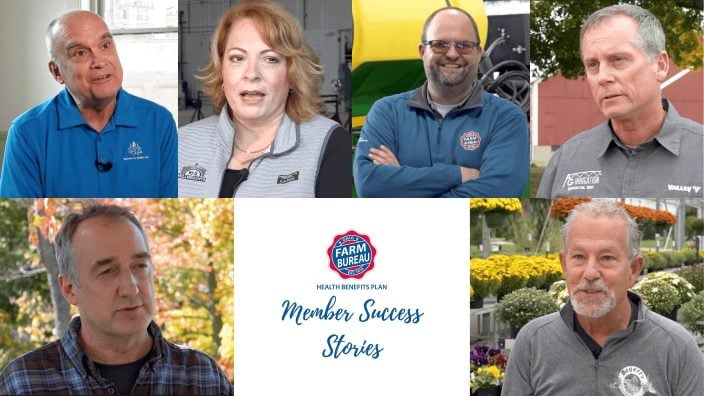Farmer’s Guide to Trucking Regulations available to Ohio Farm Bureau members
The guide includes a farm driver checklist, overview of state and federal regulations and exemptions, CDL qualifications and more.
Read More
I think Charles Dickens summed up 2018 for farmers and agriculture with the opening sentence of A Tale of Two Cities.
It was the best of times, it was the worst of times, it was the age of wisdom, it was the age of foolishness, it was the epoch of belief, it was the epoch of incredulity, it was the season of Light, it was the season of Darkness, it was the spring of hope, it was the winter of despair…..and you get the point.
Continuing to see the benefits of Current Agricultural Use Value reform, landowners in 24 Ohio counties, saw an average 30 percent decrease in their farmland valuations and similar decreases in their taxes from 2015.
Rumors of a trade war with China kicked off 2018 and those rumors became reality around mid-summer as China and the U.S began their tariff war which hit U.S agriculture pretty hard when China placed a 25 percent tariff on soybeans imported from the U.S. (China was the largest buyer of U.S. soy). In November, the U.S and China reached an agreement to cease fire and Trump agreed to hold off on raising tariffs on Chinese goods. Even more promising, China made its first purchase since the trade war began of over 500,000 tons of U.S soybeans in mid-December. The United States-Mexico-Canada Agreement, or NAFTA 2.0, was reached in 2018 as leaders signed off on the trade deal.
I think we all spent our spring hoping for the weather to cooperate, for commodity prices to improve by harvest, and for our fearless leaders to find a solution to fix the tariffs that many farmers saw as a problem. While many farmers felt it was long overdue, it was only natural to fear what trade was going to do to the bottom dollar.
We experienced a heartbreaking loss of dairy farms in 2018. As of October 2018, Ohio alone has lost a devastating 172 dairy farms in just 12 short months. Too many cows, poor milk prices, too much milk, consumer preferences, increased production costs – no matter the reasons, the number is heartbreaking.
Farm income fell yet again in 2018 with a projected 12 percent drop in 2018. USDA’s most recent Farm Sector Income Forecast revealed that net farm income in 2018, a broad measure of farm profitability, is projected at $66.3 billion. After adjusting for inflation, net farm income in 2018 is projected to be at the third lowest level in more than two decades.
With the input and advocacy of Farm Bureau members throughout the country, American Farm Bureau created a new insurance program through American Farm Bureau Insurance Services to provide some much needed help in 2018. The policy covers potential revenue loss over five quarterly insurance periods. Additionally, the Margin Protection Program introduced by USDA Farm Service Agency was revamped in 2018.
Farmers received a Farm Bill for Christmas when President Trump signed the 2018 Farm Bill passed by Congress. The work of commodity groups and grassroots organizations like Farm Bureau spent a great deal of time in discussions and negotiations with elected officials throughout 2018. The 2018 Farm Bill encompasses the Supplemental Nutrition Assistance Program (which was largely unchanged), legalized the production of hemp, provides grant funding for urban farmers, builds and maintains a livestock vaccine bank, exempts maple and honey producers from FDA’s added sugar label, and provides conservation provisions to farmers and ranchers. The Farm Bill even gives attention to mental health as opioid addiction and suicide rates spike in rural areas.
In September, a meeting was held with leaders in counties across the Western Lake Erie Basin watershed in response to Governor Kasich’s executive order issued over the summer. The order would impact eight watersheds and more than 7,000 farms and is still being reviewed by a subcommittee of the Ohio Soil and Water Conservation Commission. The watershed in distress designation was tabled by the commission until 2019. While this doesn’t immediately impact northeast Ohio, the concern many of us share is that the one size fits all approach being taken would devastate agriculture in northeast Ohio. We already experience shorter, less than ideal planting and harvesting periods and putting even more restrictions on manure spreading would cause many hardships on farmers. Water quality continues to be a top priority and we will continue to educate and encourage farmers on Best Management Practices and nutrient management.
Although we have had a “mild” winter thus far in northeast Ohio, it definitely hasn’t helped our grain and livestock farmers out. It’s January, and fall harvest still isn’t complete for everyone and with the weather forecast, the outlook isn’t improving..and neither have the prices. On a positive note, the grape and wine industry in northeast Ohio experienced a pretty good harvest despite the above average rainfall and the extreme heat that plagued much of the area. In the Grand River Valley, wine tourism in 2018 is expected to generate $15 million. Overall, fruit production in northeast Ohio had a decent harvest as well. Some orchards had issues with their Honeycrisp crop, but despite the excessive rain and heat which also made it difficult getting in the fields, most orchards were pleased with their crop in 2018. Many orchards with “pick your own” options also saw a decrease in income with all the rain since many weekends were filled with — you guessed it — rain. It was a year for the ducks.
So as we begin 2019, thank a farmer- the work they do feeds and clothes you. Among much more, pray for those who have had to make or will soon be making the heartbreaking, devastating choice to give up their passion and livelihoods, and let’s hope 2019 has many more “best” times and a whole lot less “worst” times.
Mandy Orahood is an Ohio Farm Bureau Organization Director serving Ashtabula, Geauga, Lake, and Trumbull Counties. Mandy can be reached at [email protected].


The guide includes a farm driver checklist, overview of state and federal regulations and exemptions, CDL qualifications and more.
Read More


ODA will enroll 500,000 acres into the program for a two-week sign-up period, beginning April 22, 2024, through May 6, 2024. Contact local SWCD offices to apply.
Read More

Katie Share of Columbus has been named ExploreAg and Youth Development Specialist for Ohio Farm Bureau.
Read More

Mary Klopfenstein of Delphos has been named Young Ag Professional and Ag Literacy Program Specialist for Ohio Farm Bureau.
Read More

The plan has been updated to give sole proprietors access to more rate stability and a smart solution that offers potential savings on health care.
Read More

The American Farm Bureau Federation, in partnership with Farm Credit, is seeking entrepreneurs to apply online by June 15 for the 2025 Farm Bureau Ag Innovation Challenge.
Read More

Adele Flynn of Wellington has been elected treasurer of the Ohio Farm Bureau Federation and now holds the third highest elected office in Ohio’s largest and most influential farm organization.
Read More

Producers are urged to work with their veterinarian to practice enhanced biosecurity measures and review and limit cattle movements within production systems.
Read More

The changing seasons bring with them the need to thoroughly inspect pole barns for any damages that may have occurred during the winter months.
Read More

Hundreds of Ohio businesses and sole proprietors are raving about Ohio Farm Bureau’s Health Benefits plan with lower, predictable costs and easy enrollment and administration options.
Read More